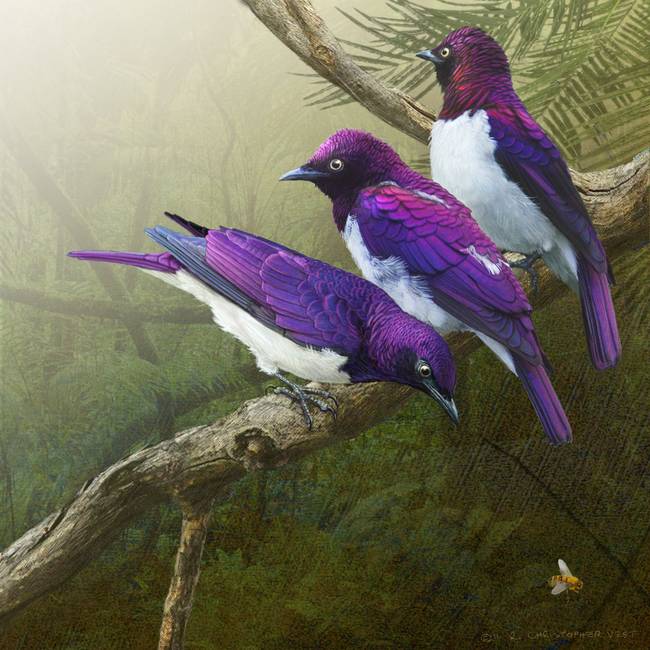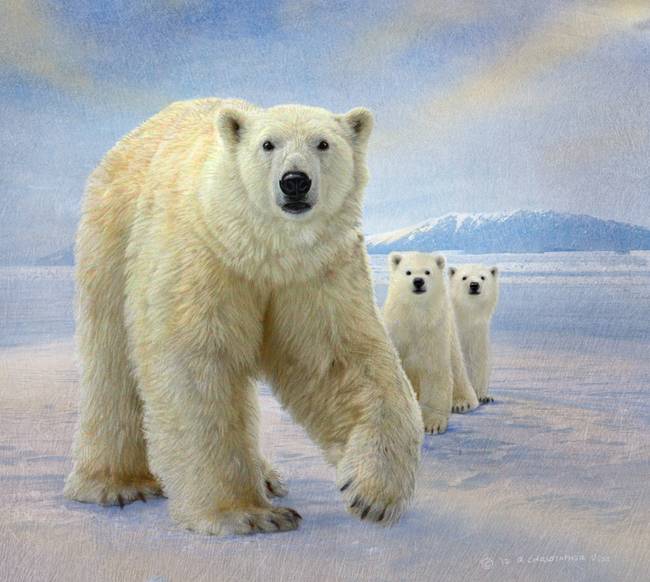 |
| "Sunrise on the Marsh 2: Sandhill Cranes" by R. Christopher Vest |
Artist R. Christopher Vest creates painted photo montages of all things nature: whether his subject is landscapes, wildlife, or domestic animals, his camera and tablet bring that subject to life and celebrate its natural beauty.
Something that makes Vest's work so eye-catching is the nuanced degrees of realism. As the viewer looks at a piece, he or she might reflect on how beautiful the lighting is, how perfectly an animal is posed, how delicately a leaf is turned in the wind--and as the viewer continues to look, more and more of the piece's painted aspects emerge, showing just how fine the line can be between a photograph and a painting.
Vest lives on a farm in Colorado, and is working with his partner Cathy to restore the land while also operating a small animal shelter. Like so many artists, his life outside of his art still seems to inspire his pieces.
 |
| "African Starlings" by R Christopher Vest |
Describe your technique of painted photo montage.
I coined the phrase 'painted photo montage' to describe my process of building images with both digital painting and photography. It seems there is a bit of bias against this evolving medium from pure photographers and painters. While photo-manipulation is accepted in computer gaming and in the movies, in the fine arts realm we still have some respect to be earned to get beyond the notion of trickery accomplished by the pushing of a button in Photoshop. I like to remind folks that many of these techniques were pioneered around the turn of the century (that would be 1900, not 2000) by a group of photographers called the "photo secessionists" organized by Alfred Stieglitz. The movement strove to bridge the perceived chasm between photography-- which was thought of as merely a documentary medium-- and fine art.
 |
| 'Ein Sommertag' by Kuehn |
Many of the core elements that are contained in modern Photoshop software were in fact done by hand by these skilled artisans in the darkroom. This includes dodging and burning, layering, masking and overt manipulations in the form of "sketching" upon the plates as shown in this Heinrich Kuehn piece "Ein Sommertag" produced in 1898. It is not immediately evident what medium this picture is. I find the beauty--especially the contrived textures-- of such early works of manipulated photography to be highly inspiring, though of course I use full color and thankfully don't have to bathe my images in chemicals to develop!
My explorations into making photographs "better" began with bird portraits, so we'll use my avian art as an example. The world is crowded these days with skilled photographers using enormous lens and expensive cameras, strobes, tripods, guided safaris to exotic lands and vast disposable income to produce brilliantly detailed pictures of birds. I have no such state-of-the-art gear, and neither the purse nor patience, so my soft-focus pictures by comparison would be of little interest unless I undertook to improve or evolve them.
 |
| "Moonlight Snipe" by R. Christopher Vest |
I assemble-- in PS layers-- the constituent parts of my picture. My textural and design components are woven throughout the image: fading in here, inverting there, both in front of and behind the subjects. There is a great deal of trial and error. My pictures typically have at least a dozen layers set at various opacities and effects, and with multiple masks. Which is not to say that being a complex amalgamation is the point. I do not want my image to fool people with a seamless photographic manipulation: I want it to be obvious that the image is the product of imagination as well as digital equipment. A typical question I get is "Is this a photograph or a painting?!?". Like the secessionists, my simple answer is "yes."
 |
| "Colorado Forest Scrub Jay" by R. Christopher Vest |
How do you promote your work?
I do almost nothing to promote my work. This may in some way account for my lack of success. I do have a licensing agent and a couple hundred images out there supposedly striving to gain royalties, but in this economy 5 per cent of doodly-squat doesn't produce the lucre to bribe a wino. I have entered a few juried shows and paid the submission fee. Your money vanishes and you don't get a critique or any sense that your art has even been gazed upon, however briefly. You don't get a coffee cup or a tote bag for the "donation"-- you don't even get a thanks. I had a gallery show but the response was tepid and shortly thereafter the gallery burned down. Maybe God is trying to tell me something. I joined an artists' website but then learned they already had 95,000 artist members. Cynicism aside, I think that unless you're Andy Warhol or Cristo with the personality to electrify the world, I think that there must be some value in being understated. Popularity is a fad: an entire school of fish will move as one toward a bright shiny object, but true explorers (art buyers) enjoy the glory and self-satisfaction of a true discovery. I guess I must await my patron Magellan or Captain Cook.
Where do you draw inspiration?
In the meantime there are sunsets and songbirds, the passing of the leaves and the coming of frost; I appreciate little glimpses of, and momentary appreciations of strong light and shadow. Sometimes they meld into the elixir of creativity, more often they get lost along with the car keys. I run an animal rescue ranch, thus my day is more about wags, barks and vacuuming dog hair than about trying to outshine or outsell those other 94,999 artists. But like all artists, I'll keep on making pictures as long as I'm able, knowing that one day I may need to explore the creative possibilities of waiting tables or driving a bus.
 |
| "Polar Bear Family Variation" by R. Christopher Vest |
You can see more of R. Christopher Vest's work at his prints site or his photo gallery.
Hope it's not too late to comment, but thank you for interviewing Chris Vest, whose art I've only recently "discovered" on Imagekind. Thoroughly enjoy his down-to-earth and somewhat cynical sense of humour! Definitely will study his work in more detail and hope eventually to learn a bit as I'm also a mediocre photographer feeling overwhelmed by the "perfect" images produced by those with more skill, patience, and fancy gear.
ReplyDeleteIt's never too late to comment, Scotch! Thanks for reading. I've been looking for a new artist to interview if you're interested. I'd like to write more about this issue with photographers!
ReplyDeleteI find Chris Vest's work to be outstanding!
ReplyDeleteI have purchased The Singing Quail & I am waiting delivery of the image.
Esther